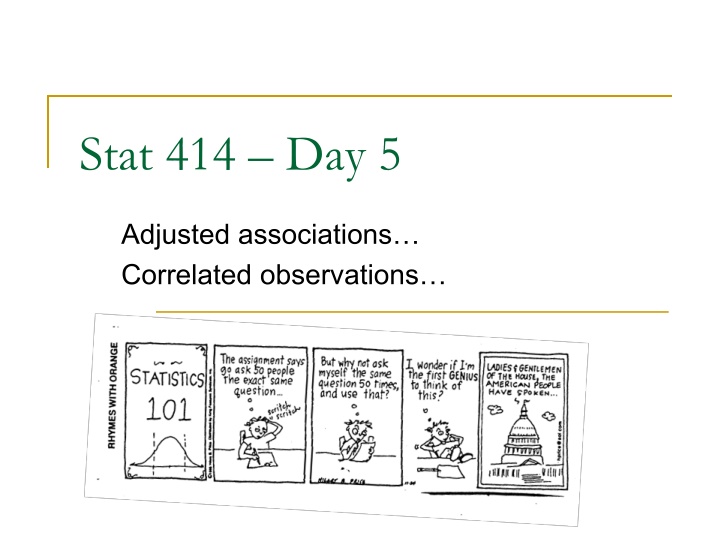
Insights on Adjusting Associations & Categorical Predictors in Statistical Analysis
Discover the importance of adjusting for correlated observations, understanding heterogeneity impacts, and coding categorical variables in data analysis. Learn about incorporating ecological information, testing variable significance, and more. Explore statistical concepts to enhance your data interpretation skills.
Download Presentation

Please find below an Image/Link to download the presentation.
The content on the website is provided AS IS for your information and personal use only. It may not be sold, licensed, or shared on other websites without obtaining consent from the author. If you encounter any issues during the download, it is possible that the publisher has removed the file from their server.
You are allowed to download the files provided on this website for personal or commercial use, subject to the condition that they are used lawfully. All files are the property of their respective owners.
The content on the website is provided AS IS for your information and personal use only. It may not be sold, licensed, or shared on other websites without obtaining consent from the author.
E N D
Presentation Transcript
Stat 414 Day 5 Adjusted associations Correlated observations
Last Time - Heterogeneity of the responses at each x Of market share values with a discount and without a discount Normality of market share values with a discount and without a discount Linearity of mean market share with a discount and without
Last Time - Heterogeneity Impacts the estimates of the standard errors of the coefficients. Could just adjust these (HC standard errors) In our view, heterogeneity is interesting ecological information that you should not throw away, just because it is statistically inconvenient. With a little bit of extra mathematical effort, heterogeneity can be incorporated into the models and can provide extra biological information. (Zuur et al.)
Last Time Categorical predictors If have k categories Add k -1 dummy variables (terms) to the model Effect coding vs. Indicator coding Testing significance of the variable
Coding Categorical Variables Indicator coding Effect coding +0.28 21.44-22.00 = -0.56 -0.28 Reference group A one-unit change in region Overall mean + effects
Some cool facts ?2= ???? ?, ? = 1 ??????? ??????? = 1 ??????? 2 ???? ???????
HW 2 Raw data vs. Model estimates
What does it mean to say adjusting for other variables ?
R car::avPlots(model) Residuals from regressing salary on all variables but semester vs. residuals from regressing semesters on all other variables Can the information in semesters not explained by major help explain the information in salary not explained by major?
R car::avPlots(model)
R/JMP car::leverage(model) Residuals from regressing salary on all variables but semester vs. fitted values from regressing semesters on all residuals of dummy variables on semesters Look for Strong linear association Outliers/Influential observations
Key Idea The within group association may be very different compared to the between group association
Intraclass Correlation Coefficient Between group (subject) var / Total var E(MSGroups) = ???2+ ??2 E(MSError) = ??2 So MSGroups MSError ???2 Total = (MSG MSE)/k + MSE ICC = (MSG-MSE)/k / (MSG MSE)/k + MSE = (MSG-MSE)/(MSG+(k-1)MSE)
Pairwise ICC r = .670 How correlated are pairs of observations within each major
ICC Represents degree of common environments (individuals) that observations share Proportion of total variance attributed to correlated unit (individual, cluster, etc.) Degree of homogeneity among observations from the same individual (or cluster) Anticipated correlation between two observations that are randomly chosen from the same unit (individual, cluster, etc.)
R install.packages("ICC") install.packages("multilevel")
To Do Quiz 5 (Wed 7am) Computer problem 5 (Wed 7am) Review HW 2 solutions HW 3 Project proposals
